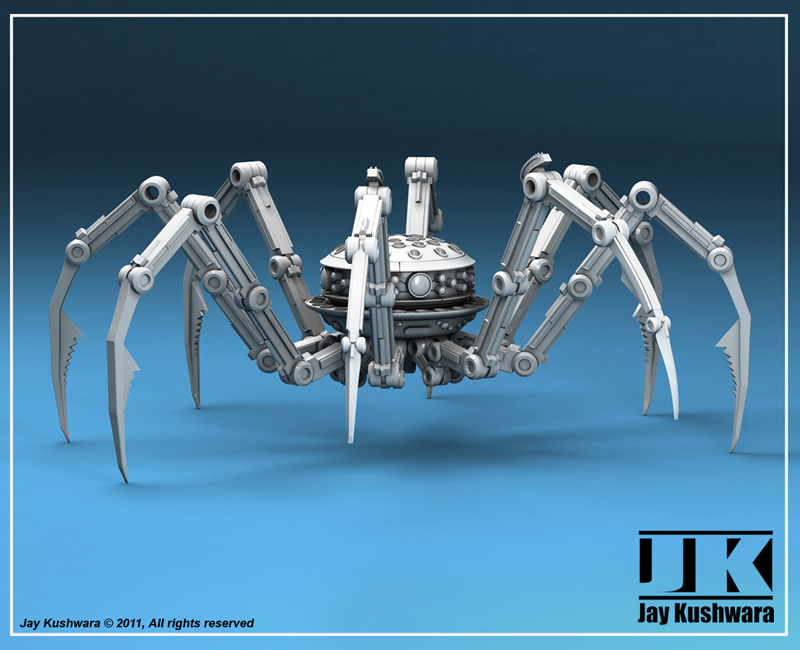Well-Known Member

OUT OF CHARACTER INFORMATION
Intent: To create a droid for future submissions and role-playing.
Image Source: [X]
Canon Link: N/A
Primary Source:
PRODUCTION INFORMATION
Manufacturer: Visanj T’shkali
Affiliation: Closed-Market
Model: Arachne Service-Maintenance Droids (“Crawlers”)
Production: Mass-Production
Modularity: Yes
Material(s): Reinforced Duraplast, Quadanium, Electronic Components
TECHNICAL INFORMATION
Classification: Second Degree
Weight: 0.255m
Height: 0.38m
Movement: Octopedal
Armaments: None
Misc. Equipment:
- Onboard encrypted short-range communications systems, allowing them to link wirelessly and securely to coordinate with one another and to receive commands, information, and make reports to and from the ship’s crew and computers.
- Various engineering tools, including micro plasma cutters, sealant gel injectors, drills, etc.
- Various cleaning supplies, including small powerful vacuums, decontamination sprayers, etc.
- Tracking beacons, allowing them to be monitored and directed.
- Magnetic anchor systems to allow them to scale walls, walk inverted across ceilings, etc.
- Onboard sensors and multi-spectrum photoreceptors to diagnose and attend to various issues.
- Stored in ‘nests’ where up to as many as 30 of these droids are kept in low-power mode and out of the way, a single nest is good for ships under 100m, where additional nests are needed for each additional 100m.
- Crawlers can use a wide array of onboard tools and equipment to fix almost any damage or issue on any type, class, or size of ship, and since a single droid can clean up more than 0.45kg of dust and 100 square meters of surfaces before needing to be recharged, a single nest can keep a small starship tidy and running like a top.
- Able to resist significant amounts of heat, radiation, and EMP/ion threats, the Crawlers rely on their small size and resilient construction to move throughout the ship to go where most technicians and engineers cannot, fitting into tight spaces and moving about inside conduits to make repairs.
- Able to fix most any issue and maintain a starship in clean, good working order indefinitely with one nest (30 droids) required for every 100m.
- Heuristic programming and encrypted links to ship’s computers, schematics, and sensors give these droids the ability to quickly learn and adapt to solve and repair any number of issues.
- Crawlers in a single nest often stagger charging sessions to ensure 2/3 of the nest is charged and ready or engaged in maintenance and repair work at all times.
- Crawlers avoid crew and passengers in most cases, performing their labors whenever possible away from them so as to be ‘under-foot’ or to obstruct or inconvenience them, and while not always possible, most days you will never know they’re there.
- Having no dedicated weaponry or combat programming, these droids avoid conflict and generally flee from danger and offer no substantive support to users in the throes of battle.
- The small droids have generally very little armor and can be easily disabled with most any direct physical attack against them, and can be damaged pretty easily. For this reason, they often require minor repairs and are best used in groups, as relying on a single Crawler to fix or maintain a starship is not reliable.
- On a full 4-hour charge, a Crawler can operate at full tempo for up to 20 standard hours before needing to be recharged. However, in instances where droids become exhausted or may not be fully-charged, large-scale damage or serious systemic malfunctioning might take time to resolve and should the droids be unable to be recharged will become entirely useless and ineffective once exhausted.
- Cannot operate on the external surface of a starship while in space, and require being docked at dedicated repair facilities, dry docks, or at the very least, landing planet-side somewhere. Crawlers need to have access to materials to make repairs, and without these materials, they become distinctly less successful.
The concept of spider repair droids was nothing new, novel, or particularly innovative. The reason Visanj created these droids then, was not to break into some new field or fill a certain void, but to create an improved model, capable of working in better coordination and using heuristic programming and information from ship’s computers to better perform their duties. The Arachne droids would be at once ubiquitous, seemingly constantly working and going about their duties, and yet surreptitiously avoiding crew and passengers (in most cases). Able to operate long hours in confined spaces and under difficult conditions, these little guys can fix most any problems. Though, to do so effectively, they require available charging in their ‘nests’ and access to materials with which to make repairs, and should they not have either, they will not function as intended.







